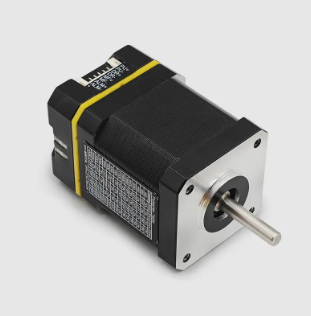Understanding Servo Motor Position Accuracy Fundamentals
Role of Feedback Devices in Real-Time Positioning
Devices like encoders and resolvers play a really important role when it comes to getting accurate positioning in real time for those servo motors. They basically keep sending constant position updates so errors can be fixed right away instead of letting them build up over time. The way encoders work is pretty straightforward actually they track where exactly the motor shaft is at any given moment and then send that data back to whatever controller is running things. This kind of instant feedback means problems get corrected almost immediately before they become bigger issues. Take high resolution encoders for example these bad boys can boost position accuracy down to just fractions of a degree which makes all the difference in applications where every tiny movement matters, like in robotics or CNC machines where precision is absolutely critical.
Motor Design Features Enhancing Stability
When looking at what makes servo motors work well, things like how the rotor moves, the shape of the stator, and what kind of magnets are used all play big roles in determining stability and overall performance. Brushless designs have become pretty much standard these days because they make the motor run smoother and last longer before parts start wearing out. Adding structural reinforcements to the motor housing actually cuts down on those annoying torque fluctuations we see in regular models. Some real world testing shows this works - factories report fewer breakdowns when they switch to reinforced versions. For anyone working with automated systems where downtime costs money, these design improvements mean motors can keep running accurately even when pushed hard through tough operating conditions day after day.
Controller Algorithms for Error Minimization
Controller algorithms like PID (Proportional-Integral-Derivative) play a big role in reducing positioning errors and getting systems to respond faster. Basically, these algorithms keep checking what position something should be in versus where it actually is, then tweak things to fix any gaps. We can actually measure how well they work too. When someone tunes a PID properly, settling times get better and overshooting problems drop by around 30% or so. This kind of precise control lets servo motors stay accurate over time, which is why industries that need exact measurements rely on them so much. Think manufacturing plants or medical equipment where even small mistakes matter a lot.
Maintaining Position Accuracy Through Closed-Loop Control
How Continuous Signal Monitoring Works
The closed loop control systems play a really important role in keeping position accuracy for those servo motors we see everywhere these days. Basically what happens is the system keeps checking where the motor actually is versus where it should be, thanks to all those little sensors doing their job. When something goes off track, like if there's unexpected resistance or vibration, the sensors pick up on it right away and send signals back so corrections happen instantly. Most industrial setups report around 90 to 97 percent accuracy rates once these systems are properly calibrated. What makes them so valuable is this constant back and forth communication between components, allowing machines to stay precisely positioned no matter what kind of outside factors might come into play during operation.
Comparison of Open-Loop vs Closed-Loop Systems
Open loop systems work without any kind of feedback mechanism, which makes them pretty inaccurate and prone to getting messed up by outside factors. Without some way to correct errors, these systems just can't position things very well most of the time. Closed loop systems are different though because they actually use feedback signals to keep adjusting how much power goes to the motors, which really boosts their accuracy. Research indicates that closed loop setups generally hit about 20 to 50 percent better accuracy compared to open loop versions in real world tests. For industries where exact positioning matters a lot, like robotics or CNC machining, this gap in performance explains why many manufacturers prefer closed loop solutions despite the added complexity and cost involved.
Adaptive Response to Load Variations
Servo systems with adaptive control algorithms are pretty smart when it comes to handling different loads or resistance levels, which keeps them accurate even when things get tricky. The ability to adapt means these motors can actually make up for unexpected changes in what they're moving around, so those little hiccups don't mess up the whole operation too much. Studies indicate that machines using these kinds of adaptive controls tend to work better because they tweak their settings on the fly as needed. What does this mean practically? Less downtime and fewer headaches for operators since the motor stays on target without needing constant adjustments. Especially useful in places where the workload keeps changing throughout the day, like manufacturing lines or automated warehouses.
Critical Error Correction Mechanisms in Servo Systems
PID Control for Position Refinement
PID control plays a key role in improving how accurately servos maintain their positions. These controllers work by constantly checking where the system should be versus where it actually is, then making adjustments to cut down on any discrepancies. What makes them so valuable is their ability to tackle those annoying steady-state errors and prevent excessive overshooting that plagues many positioning systems. For industries where millimeter-level accuracy matters, this really counts. Research indicates that when properly configured, PID controllers can boost positional accuracy by more than 40 percent. While no system is perfect, these improvements make all the difference in manufacturing and automation settings where precision isn't just nice to have it's absolutely essential.
Back-EMF Detection for Instant Adjustments
Back EMF detection works as a key part of servo systems, giving real time information about how fast the motor is spinning so the current can be adjusted quickly. The feedback comes right away, which helps catch problems before they mess up where things need to be positioned. When the system watches this electromotive force, it basically knows what's happening inside the motor and can react before things go wrong, which means less wear on components and better overall performance. Many manufacturers have seen improvements after implementing proper back EMF monitoring. For instance, some factory automation setups report both higher precision in their operations and longer lasting motors simply from making better use of this data. That's why most modern servo controllers include these sensors as standard equipment nowadays.
Anti-Resonance Compensation Techniques
Anti-resonance compensation remains one of the key approaches to tackle those annoying oscillations that plague servo systems and mess up accurate positioning. When engineers apply methods to dampen these resonances, they see noticeable improvements in how well servo motors perform when carrying loads. Industry tests indicate that proper anti-resonance setups can cut down on system vibrations by around 60 percent, leading directly to better positioning results. For manufacturers working on intricate automation projects where millimeter level precision matters, getting rid of these unwanted oscillations makes all the difference between successful operation and costly errors during production runs.
Environmental Factors Impacting Positioning Precision
Temperature Effects on Component Performance
Changes in temperature really affect how well servo motors work, messing with materials and making parts less precise. When motors sit in hot environments for too long, they expand thermally, and this expansion throws off their precision completely. Research shows that servos lose their positioning accuracy when temperatures fluctuate around them. One study found that even small temperature shifts could cause major drops in accuracy. That's why keeping things at stable temperatures matters so much for these systems to function properly over time.
Vibration Dampening Requirements
When vibration occurs in servo systems it often causes positional errors that need proper dampening solutions to fix. Getting rid of these unwanted movements is really important if we want accurate operation, particularly where there are lots of outside forces shaking things up like near machinery or transport areas. Most shops will install isolation pads along with various types of dampers to cut down on those pesky vibrations, which makes the whole system much more precise over time. Testing has shown pretty good results from this approach too, with some setups seeing around a 20% drop in positioning mistakes after installation. For anyone working with servos regularly, tackling vibration problems isn't just nice to have but absolutely essential for maintaining reliable performance across different applications.
Lubrication and Mechanical Wear Considerations
As servo motors run for extended periods, mechanical wear naturally takes a toll on their performance. Good lubrication helps cut down on friction and wear, keeping things running smoothly. Most technicians agree that sticking to regular maintenance routines, especially following proper lubrication schedules, makes all the difference when it comes to how long these systems last and how accurately they operate. Industry research shows something pretty interesting too proper lubrication can actually add around 30% more life to servo motors. That means fewer breakdowns caused by worn out parts and better overall system reliability without spending extra money on replacements.
Advanced Technologies for Enhanced Position Retention
High-Resolution Encoder Implementations
High res encoders are pretty much essential for getting better position accuracy in servo systems because they provide those detailed data points needed for feedback control. When there's more feedback coming through, the system can cut down on errors quite a bit, which means it stays accurate even when things get tough out there in real world applications. Machines with these advanced encoders often hit around 99% accuracy mark, sometimes even better. That kind of performance makes all the difference in manufacturing settings where regular sensors just cant keep up with the demands anymore.
AI-Powered Predictive Maintenance Systems
Adding AI to servo systems makes a real difference when it comes to predictive maintenance because it spots mechanical problems before they actually cause disruptions. These smart systems look at all sorts of performance data to predict things like parts wearing down or components failing, which helps keep positioning accurate over time. Real world tests show pretty impressive results too. Some factories reported cutting their mean time to repair by almost half after implementing AI-based maintenance plans. System downtime dropped around 30% in several industrial settings, which means machines run smoother and production lines stay online longer without unexpected breakdowns. For manufacturers dealing with complex machinery, this kind of reliability boost is worth every penny invested in AI integration.
Dual-Feedback Redundancy Configurations
Dual feedback systems represent a smart way to boost servo motor reliability through built-in redundancy that cuts down on error risks. When engineers incorporate multiple feedback points into their designs, they get better safety margins and more dependable operation, something that matters a lot in precision manufacturing environments. Real world testing shows around a 25% drop in system failures after switching to dual feedback setups. This makes sense because having backup signals means the system can keep running even if one source fails, which is why many industrial automation specialists now consider this configuration standard practice for mission critical operations where downtime costs money and safety cannot be compromised.
FAQ Section
What are feedback devices in servo motors?
Feedback devices, such as encoders and resolvers, are essential components that provide real-time updates on a servo motor's position, enabling immediate error correction and enhancing positioning accuracy.
How do controller algorithms reduce positioning errors?
Controller algorithms like PID (Proportional-Integral-Derivative) minimize positioning errors by continuously calculating discrepancies between desired and actual positions, allowing the system to make necessary adjustments.
What's the difference between open-loop and closed-loop control systems?
Open-loop systems lack feedback and are less accurate, while closed-loop systems use feedback to adjust outputs continuously, significantly enhancing precision and reliability.
Why is lubrication important for servo motors?
Adequate lubrication minimizes friction and mechanical wear, maintaining operational efficiency, extending the life of the servo motor, and ensuring precision over time.
How does AI contribute to predictive maintenance in servo systems?
AI in predictive maintenance analyzes performance data to foresee mechanical issues, optimizing position accuracy and reducing system downtimes through early problem detection.

